Please note that this review does not include the Kinect/Move features of Virtua Tennis 4. I’m not made out of money. Leave me alone!
Why are tennis players terrible at relationships? Because love means nothing to them. Get it?
That corny joke covers the whole of my tennis knowledge. Honestly, I have held a tennis racket maybe four or five times in my life, and even then it was just to thwack balls as hard as I could over the court fence while my gym teacher wasn’t looking.
So why is it that I fell so madly in love with Virtua Tennis? The first entry on the Dreamcast held my attention captive for a good year. I couldn’t get through a day without at least one set of its mesmerizing and mind-bogglingly fun matches. While holding the distinction of having some of the most polished and accurate tennis gameplay out there, it somehow managed to elegantly balance that with Sega’s trademark sense of arcadey pick-up-and-play entertainment. By mixing in ludicrously enjoyable mini games with pitch-perfect physics and pinpoint-accurate control, Sega managed to build a concoction that was notoriously hard to put down for sports fans and stingy gamers alike. It did something for me that I never thought imaginable – It made sports really, really fun.
But for me, that was years ago. With its new Match Momentum feature, a completely overhauled World Tour mode, and a honed online experience, can the fourth iteration of the series recapture the magic that has long since been overshadowed by sims like Top Spin? Hit the jump to find out.
When starting up a game in Virtua Tennis 4 for the first time, it’s immediately obvious to anyone who’s experienced the series before that the core gameplay is indeed intact. The control scheme is still a breeze to pick up, and will have you utilizing slices, lobs, top spin and serves like a pro in no time. There is more emphasis placed on preparing your swing in anticipation of returning the ball, but all in all the gameplay remains exceedingly accessible. Whereas so many other sports games tend to intimidate newer players with a bevy of unnecessary bells and whistles, Virtua Tennis 4 elects instead to challenge the player to approach its simple controls from various new angles.
This is evidenced by the new play styles of the game. Just about every time you face a new opponent, you will be forced to scrutinize and adapt to the way that particular person plays. Some players use the “Big Serve” play style, making aggressive charges to the net and spiking anything you throw at them. Some players use the “Varied Shots” play style, switching up regular hits with a bevy of lobs and slices to catch the other player off guard. With so many titles out there promising diverse play experiences but never really delivering, I found myself consistently surprised at how I was encouraged to modify my technique to find new ways to defeat my opponent.
These play styles are what fuel one of the most touted features of Virtua Tennis 4 – the brand new Match Momentum mechanic. Over the course of a match, a “Concentration Gauge” at the top of the screen fills up based on how you play. If you are using a player with the Big Serve play style, your meter fills up a little bit every time you send out a strong serve or spike the ball. If you utilize the Solid Defence play style, you are rewarded on your Concentration Gauge for returning difficult shots and extending rallies. Once your gauge is full, you can hit B to unleash your “Power Shot,” a searing high-speed shot that is extremely difficult to return. This effective new feature has the capacity to completely change the direction of a match, giving one last chance to players who are dwindling on the ropes, or offering that extra edge needed to win a match. While some may scoff at this as a cheap way of leveling the playing field, the fact that players have to cater to their play style means that they have to earn that special shot. It’s a nice way to reward players for reading their opponents and adjusting their own moves accordingly.
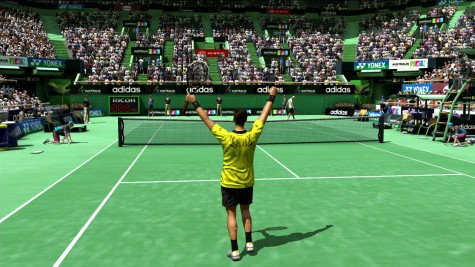
While Match Momentum is effective in getting players to learn the nuances of how the game can be played, that’s not to say it doesn’t come with own set of headaches. This feature, while helpful for players who are learning the game, is relatively unbalanced between play styles. Some styles fill the Concentration Gauge almost immediately, as they require simple and easily executed shots. Other play styles demand quite a bit more skill, and certain match-ups suddenly feel a little unfair just because of conflicting and unbalanced characters. Adding to this frustration is the fact that the camera cuts away from the main action every time a Power Shot is activated. This is a bit disorienting, especially for the person who is now burdened with the task of returning this near-impossible volley.
Besides Match Momentum, the other big feature that Sega seems to be touting with Virtua Tennis 4 is the fleshed out World Tour mode. This mode allows players to create their own character, choose their own play style (which can be changed at any time by purchasing a new play style lesson), and traverse a board-game-like map on a journey to become a star athlete. Players use roll-of-the-dice “Movement Tickets” to progress their characters along the map to different exhibition matches, charity events, hotels, Tournaments, and party games to increase their star power and level up their character’s stats.
While this mode is a nice way to flesh out the overall package of Virtua Tennis 4, the unforgiving board game structure quickly transforms things from engaging to annoying. Since your movement across the board is restricted to how much the movement tickets will allow, you will repeatedly find yourself unable to get to crucial matches or charity events that will give you the star power necessary to enter the next tournament. If you subsequently miss any single tournament, you lose such a crucial amount of potential stars that it becomes impossible to keep up with the pace that the game asking of you. In my first play through, I was only able to enter the first three tournaments. After I failed to win the third tournament, I quickly slipped so far behind in the game that I was struggling just to reach the final goal of each season without a substantial penalty.
This unforgiving nature is somewhat exacerbated by the strange case of scoliosis that afflicts the spine of the Tour mode’s difficulty. Throughout the entire game, I didn’t find a single doubles match that challenged me even remotely. Most single matches seemed manageable, but every once in a while I’d stumble upon a player against whom I didn’t stand a chance. Since crucial matches can’t be retried, a loss is a loss is a loss, and you are forced for the rest of the tour to pay for your mistakes.
All of this being said, it is a good sign that I was inspired to return to the World Tour mode as soon as I finished my first go around. While it is unfair in its structure, I found some of its strategic elements rather appealing. Throughout the Tour, you have to manage your player’s condition by periodically stopping at hotels or buying Recovery Tickets. If your player is at their peak condition, they will perform better on the court, and their Concentration Gauge will fill faster. If hit the court in poor condition, they will slow down, and getting a Power Shot off becomes much more difficult. While this did add some frustration once I was behind, I actually found myself enjoying the balance of recovering, hiring agents to gain extra stars, and avoiding accidents that deplete money and health. If the developers had been a little more forgiving to a player’s losses, I probably would have enjoyed the Tour Mode quite a bit more.
The party games, a distinguishing staple for Virtua Tennis, are just as fun as they’ve ever been. These mini diversions range from expected (Coin Match – Collect change scattered on the court as you return volleys), to the hilariously absurd (Egg Collector – Run over eggs to make them hatch into chicks who will follow you to their mother hen), and are available to play from the beginning. You can play them alone or with friends, and while they don’t add anything substantial to the overall game, it’s nice to have this trademark put front and center as a marker of Virtua Tennis’s fun-oriented style.
Playing online is a breeze and incredibly fun with Virtua Tennis 4’s polished gameplay. I occasionally found myself deadlocked in a particularly heated match, where reading my opponents’ tendencies became essential to survival. Tennis is a touchy game for online play since so much of it revolves around snappy timing, so there was an instance or two where matches like these were ruined by the tiniest touch of lag. This didn’t happen enough to mar my overall experience, but it is a concern worth noting. My biggest gripe with the online is really just how barebones it continues to be. Doubles, Singles and Party Games are all available, but I would love to see some original modes like Tournaments or online-enabled World Tour modes to keep it from feeling like an afterthought.
All in all, Virtua Tennis 4 only delivers in the same places it has always delivered. The gameplay is still extremely addictive while maintaining that undercurrent of accessible simplicity. The added nuance of Match Momentum adds some much-needed depth and inspires a great deal of strategy, but the flawed World Tour Mode and lacking online experience still leaves me wanting more.
Virtua Tennis lobs up a solid B.

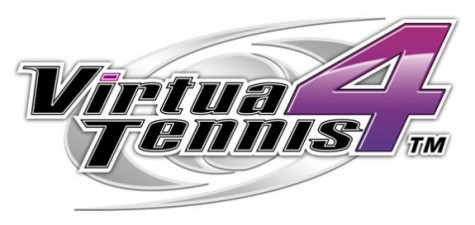
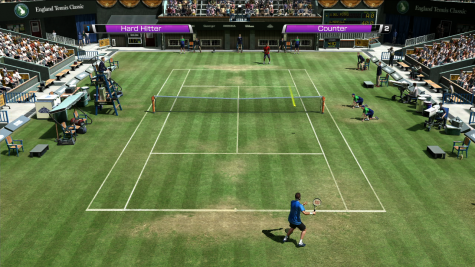
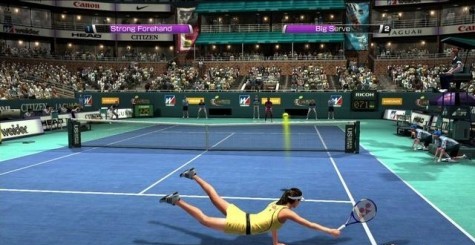

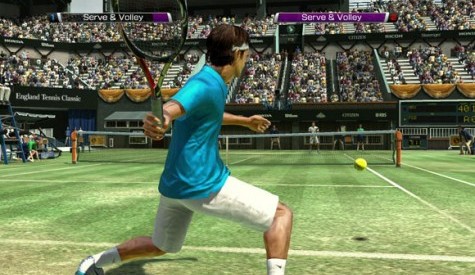

I used to love the VT franchise on the Dreamcast, and last year I bought one of the current ones for the PS3. I couldn’t believe how simplistic and just barebones it all was. This is a franchise that’s had over 10 years of development and SEGA’s still just throwing in the bare minimum? I realize by design it’s supposed to have a simplified play system to make it easy to pick up and play, but when it’s as simple as it is now, it’s really just not that fun. It’s more like a one note rhythm game or something, just pushing the button when the ball comes close to you.
Honestly, I much prefer SEGA Superstar Tennis, because that one didn’t have to stay confined in the grounds of reality and as a result Sumo could put in a lot of fun quirks like the special moves or all the franchise-related bonuses. I loved the zombie killing stuff in the House of the Dead levels, or even the originality of the Puyo Pop puzzles. If SEGA could bring that kind of depth and originality to their other franchises then maybe they’d have a chance, but at this point I’m surprised anyone cares at all about the Virtual Tennis franchise, and you can gauge as much from this well written review.
I wouldn’t say SEGA’s throwing in the bare minimum. It always felt to me like they were trying to add a fair amount of strategy to gameplay that could potentially be played competently with a single button and a joystick. It did get its start in arcades, after all.
Virtua Tennis is no sim, but to me its simplicity just feels more in line with a fast, almost instantaneous sport like tennis. The game is a snap to pick up and play out of nowhere, which is one of SEGA’s favorite things to do in almost all of their best Dreamcast games. You can throw in lobs, top spin, slices, and now power shots, but it’s also very possible to hold your own by simply learning to play the court.
I will admit that it leans much closer to sim than arcade game, but Virtua Tennis’s unique balance of 65% Sim, 35% Arcade is enough to turn a sports-hater like me into a tennis addict.
…YyyyyeahhIlikevirtuatennisgrumblegrumble…